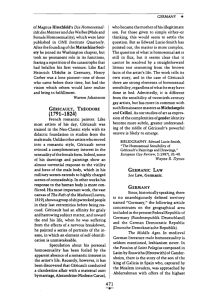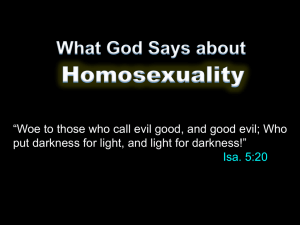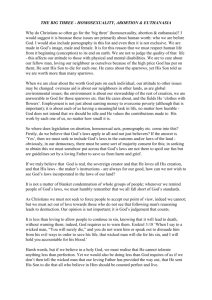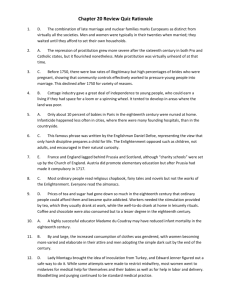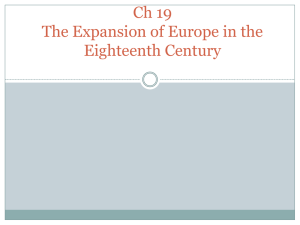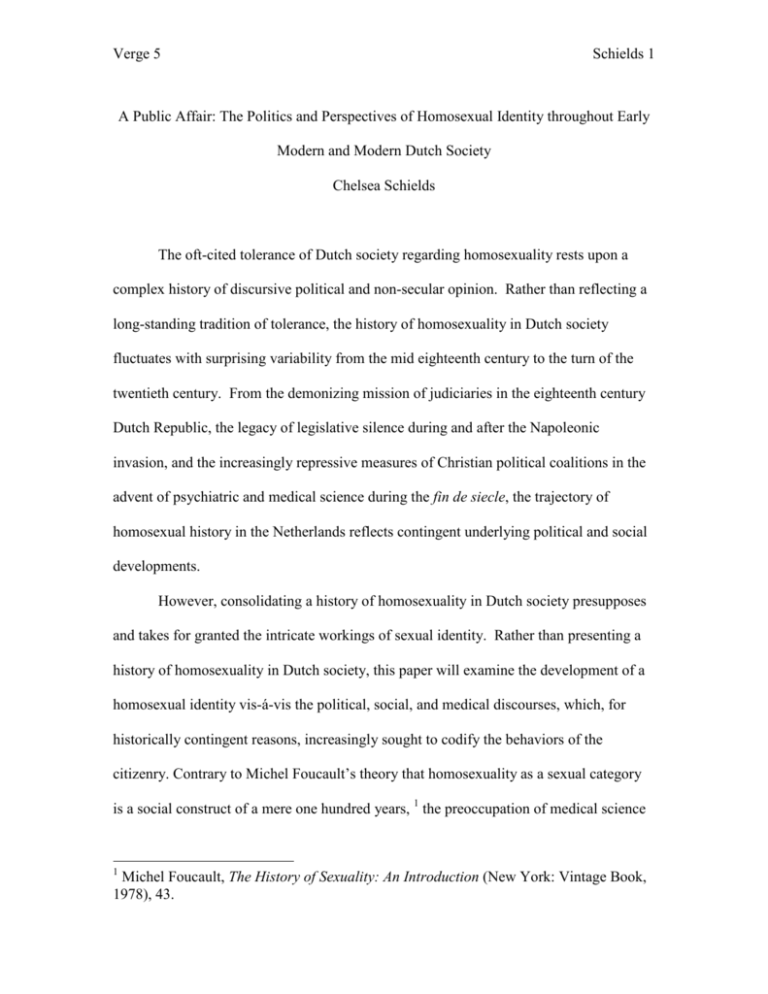
Verge 5
Schields 1
A Public Affair: The Politics and Perspectives of Homosexual Identity throughout Early
Modern and Modern Dutch Society
Chelsea Schields
The oft-cited tolerance of Dutch society regarding homosexuality rests upon a
complex history of discursive political and non-secular opinion. Rather than reflecting a
long-standing tradition of tolerance, the history of homosexuality in Dutch society
fluctuates with surprising variability from the mid eighteenth century to the turn of the
twentieth century. From the demonizing mission of judiciaries in the eighteenth century
Dutch Republic, the legacy of legislative silence during and after the Napoleonic
invasion, and the increasingly repressive measures of Christian political coalitions in the
advent of psychiatric and medical science during the fin de siecle, the trajectory of
homosexual history in the Netherlands reflects contingent underlying political and social
developments.
However, consolidating a history of homosexuality in Dutch society presupposes
and takes for granted the intricate workings of sexual identity. Rather than presenting a
history of homosexuality in Dutch society, this paper will examine the development of a
homosexual identity vis-á-vis the political, social, and medical discourses, which, for
historically contingent reasons, increasingly sought to codify the behaviors of the
citizenry. Contrary to Michel Foucault’s theory that homosexuality as a sexual category
is a social construct of a mere one hundred years, 1 the preoccupation of medical science
1
Michel Foucault, The History of Sexuality: An Introduction (New York: Vintage Book,
1978), 43.
Verge 5
Schields 2
with homosexual identity in the late nineteenth century borrows from the highly
dramatized portrayal of sodomites in the mid eighteenth century. The discovery of an
extensive network of sodomites in the eighteenth-century Dutch Republic fundamentally
changed the perception of sodomy as a casual aberration and characterized sodomites as
an inherently separate group of morally confounded individuals. At several points in the
late eighteenth century, dramatic spectacles were made of sodomites throughout the
country. The intervals between these episodes, however, did not seek to radically
eliminate, prosecute, or redefine society along this basis despite the prevalence of
widespread moral opposition.
The beginning of the nineteenth century drew the Dutch Republic under French
military occupation and subsequent assimilation into the Napoleonic Empire, which
promoted nearly a century of legislative silence regarding sodomy. The Code Napoléon,
which decriminalized sodomy, was adopted after liberation and maintained legislative
silence throughout this liberal century in Dutch history. The fin de siécle alternatively
strays from liberal politics and reintroduced legislative bars regarding homosexual acts as
psychiatric science increasingly sought to explain the behaviors of a people considered
sick in both body and mind, a notion whose origin lies in the dramatized trials of
sodomites in the mid eighteenth century. Throughout these episodes, a homosexual
identity came to be articulated largely through the discourse of accusation and
codification. The centralizing trend of political authority beginning in the mid-eighteenth
century continued to varying degrees of success throughout the nineteenth century,
initially producing at discourse of knowledge, power, and identity that would reflect
eighteenth century medical and social preoccupation with homosexuality.
Verge 5
Schields 3
I. Towards a Homosexual Identity: The Complexity of Sexual Categorization
An immediate challenge of this research is the complex, circumstantial, and selfreproducing nature of identities. The goal of this paper is not to examine or postulate as
to whether a homosexual identity, in a Dutch or global setting, is essential or constructed.
Similarly, the point is not to claim that political and medical discourse invented a sexual
category of people who had no prior deeply felt language of self-recognition. The
language of private identification became important for the standardization of public
identification in the mid-eighteenth century, and in this way, a sodomite identity was
arguably reinforced by sodomites and non-sodomites, continuing into the scientific
discourse of homosexual identity in the late nineteenth century. Although these
confessions of self-identification among sodomite subcultures in the mid-eighteenth
century were forced into discussion, which invokes doubt of their authenticity, they
inarguably reveal a system of identification among participants of this subculture that
were carefully extracted to standardize definitions in the public setting. 2
To say that an identity was created where none existed is thus inaccurate, and it
would be similarly detrimental to claim that the language of sodomites themselves was
adopted by discourses of power to articulate a homosexual identity; an identity is not
wholly imagined, nor is it totally imposed. The question is then not whether
2
Foucault discusses the effects of turning desire into discourse and treats its subsequent
classification and codification at great length in The History of Sexuality. The process of
analytic discourse served to create and standardize sexual behaviors, presenting a model
capable of externally identifying people and internally reifying behaviors with new,
analytic connotation. In sum, the codification of sexual behavior resulted in multiple
identities that were advanced as external systems of classification while their
dissemination would inevitably be incorporated into the individual. See Foucault, “The
Perverse Implantation,” 36-49.
Verge 5
Schields 4
homosexuality is inborn or learned, or to what extent the very stuff of self-recognition
became part of the divisive discourse of power; rather, as Jeffrey Weeks asserts,
the crucial factor is not the truth or mythic nature of identities, but identities’
effectiveness and political relevance…What the historical approach has achieved
is to make us more aware of the complexity of forces that shape the social, and to
sensitize us to the power relations which organize the meanings we live by. 3
Following the development of a homosexual identity in modern Dutch society is thus
historically contingent. The paper will examine why these identities gained relevance in
their historical context and the effect of categorization and distinction on the social and
moral order of society.
Discontinuity in historical definitions of sodomy will be addressed as they arise
throughout the paper. However, it is important to establish a general working definition
of precisely what constituted a sodomitic act through the eighteenth and nineteenth
centuries. Dutch historian Theo van der Meer notes that up until and throughout the
seventeenth century, sodomy stood for any sexual technique “that was not directed to
procreation: oral and anal intercourse with male or female, masturbation, bestiality, and
even sexual intercourse with Jews and Saracens.” 4 However, in the eighteenth century a
more limited interpretation of the term prevailed, considering sodomy to be exclusively
3
Jeffrey Weeks, “History, Desire, and Identities,” in Conceiving Sexuality: Approaches
to Sex Research in a Postmodern World, ed. Richard G. Parker and John H. Gagnon
(New York: Routledge, 1995), 34.
4
Theo van der Meer, “The Persecutions of Sodomites in Eighteenth Century Amsterdam:
Changing Perceptions of Sodomy,” in The Pursuit of Sodomy: Male Homosexuality in
Renaissance and Enlightenment Europe ed. Kent Gerard and Gert Hekma (New York:
Harrington Park Press, 1989), 265.
Verge 5
Schields 5
anal intercourse (or bestiality), “and only then when the act had been committed to full:
namely penetration and ejaculation in the body of a partner.” 5 An additional challenge to
this research is to avoid confusion of sodomite and homosexual terminology. Because
the history of homosexuality seems to be defined by discrimination and victimization, 6 it
is tempting to point to the divisive language of political and medical rhetoric in the latenineteenth century as the inevitable continuity of the persecution of sodomites in the premodern and early modern historiography. This assumption, however, presupposes the
extension of sodomite to homosexual identity and ignores the process of social labeling,
including its external and internal consequence of imagination, reification, and selfreproduction.
Sodomites and homosexuals are not interchangeable terms, and though at times
the rhetoric of persecution of sodomites and homosexuals present noticeable continuity, it
is important to note that a sodomite is not necessarily a homosexual, nor is a homosexual
necessarily a sodomite. Rather I wish to point out, where they exist, why elements of
continuity were reinforced and emphasized throughout this period. Though elements of
homosexuality of a later date (namely medicalization in the late nineteenth century) do
exist as early as the eighteenth century, Dutch scholar Gert Hekma argues, “the
theoretical creation of the homosexual, with all its practical consequences, did not come
5
6
van der Meer, 265.
Gert Hekma, review of De Westenlijke Sonde van Sodomie en Andere Vuyligheden.
Sodomiten-Vervolgingen in Amsterdam 1730-1811 by Theo van der Meer in The Pursuit
of Sodomy, 491.
Verge 5
Schields 6
about until the ‘psychopathia sexualis’ of the late nineteenth century.” 7 The very term
itself was not known in the Dutch language until medical magazines introduced it in
1892. 8 It is important to recognize the complexity of identity and the terminology that
characterizes it, but it is equally important to “define strategies of power that are
immanent in this will to knowledge.” 9 This research will explore the historical
circumstances in which sodomite and homosexual identities gained their relevance and
highlight aspects of rhetorical and political continuity.
II. Society, Sodomy, and Subculture in the Early Eighteenth Century
Before examining the treatment of sodomy in the eighteenth-century Dutch
Republic, it is useful to analyze the state-institutional arrangements therein. The Dutch
Republic possessed a decentralized governmental structure, lacking both a monarch and
an official state church (though Calvinism reigned as the ‘privileged’ denomination). 10
This decentralization reflected a high degree of provincial and municipal autonomy
throughout the seven united provinces. Representatives from these provinces convened
in a loose governing body known as the States-General, but this polity did not serve as a
national legislature. Similarly, the Stadholder also occupied an ambiguous place in the
‘pluralist’ state arrangement. The Stadholder, resembling a head of state, at times
7
Gert Hekma, review of De Westenlijke Sonde van Sodomie en Andere Vuyligheden.
Sodomiten-Vervolgingen in Amsterdam 1730-1811, 490.
8
Gert Hekma, “Wrong Lovers in the 19th Century Netherlands,” in Gay Life in Dutch
Society, ed. A. X. van Naerssen (New York: Harrington Park Press, 1987), 44.
9
Foucault, 73.
10
Paula Ann Nichole Frederick, “Sexing the Nation: State Regulation of Prostitution and
Homosexuality in Britain and the Netherlands in the Nineteenth and Early Twentieth
Centuries” (PhD diss., Harvard University, 2002), 52.
Verge 5
Schields 7
possessed something close to kingly power, but they were vulnerable to pressures from
powerful elites who sought to avoid a monarchical government, and rarely did they have
jurisdiction over all the Dutch provinces simultaneously. At times the Republic simply
did not have a Stadholder. 11 Little is to be found regarding sodomy in the period
between 1600 to 1725, though sodomy sentences were occasionally registered. Dutch
historian Dirk Jaap Noordman attributes this to the fact that the criminal system in the
Republic was essentially an accusatory one, with official authorities having no
independent role in tracing and prosecuting criminal acts. They acted mostly under
pressure from the civilian population, and thus the legal foundation for the prosecution of
sodomites was mostly found in very general wording. 12 Noordman concludes that,
although some men were punished (as, at this point in time, men were the target of
sodomitic persecution), “neither stigmatization nor prosecution of sodomites was
characteristic of the attitude of the official authorities in the Republic before 1725.
Among the common people, apparent sodomitic behavior was not a reason for ostracizing
someone.” 13
Despite the seeming indifference of the authorities and common people regarding
sodomy in the early modern Republic, a law against sodomy did exist under the penal
code instituted by Emperor Charles V in 1532. The decree made sexual intercourse
between men, between women, and between humans and animals illegal, deeming it a
11
Frederick, 50-51.
12
Dirk Jaap Noordman, “Sodomy in the Dutch Republic, 1600-1725,” in The Pursuit of
Sodomy, 208.
13
Noordman, 221.
Verge 5
Schields 8
“crime against nature”. 14 Foucault’s analysis of the sodomite as a temporary aberration15
applies well enough to the opinion of sodomites in the first half of the eighteenth century.
The relatively ‘calm’ decades of sodomitic persecutions in the early Dutch Republic seem
to reflect the opinion that authorities and common people did not discriminate between
sexual acts between males and the mental condition of those who committed them. A
sodomite, according to L. J. Boon, was “someone who willingly debased himself by
temporarily obviating God’s commandments.” 16 This was undoubtedly a sinful act, but it
was temporary, and, like all other sins, could be forgiven by doing penance.
The transformation of casual and aberrant sodomite to someone sick both in body
and mind occurred in the mid-eighteenth century beginning with the discovery of an
extensive sodomite subculture. This assertion stands in stark contrast to the theory
articulated by Foucault, which states that the psychological, psychiatric, and medical
category of homosexuality constituted in the late nineteenth century transposed the
practice of sodomy onto a homosexual ‘species’. 17 What about the discovery of a
sodomite network, however, necessitated the overwhelming public reaction that would
follow its discovery? Why was society’s preoccupation with redefining social and moral
boundaries focused so heavily on the sodomite after centuries of relative indifference and
what were the historical circumstances that made possible, if not necessitated, the
redefinition and subsequent exclusion of the sodomite from civil society?
14
Frederick, 52.
15
Foucault, 43.
16
L. J. Boon, “Those Damned Sodomites: Public Images of Sodomy in the Eighteenth
Century Netherlands,” in The Pursuit of Sodomy, 237.
17
Foucault, 43.
Verge 5
Schields 9
To answer these questions, one must look first to the nature and development of
sodomitic subcultures in the Republic. Noordman characterizes the nebulous sodomitic
subcultures of the late seventeenth and early eighteenth centuries as being concentrated in
certain areas and employing distinctive modes of recognition and organization for having
sexual contact. 18 Van der Meer defines the sodomitic subculture as “a specific form of
organization of sexuality which differs from what is dominant in a culture, as a means of
passing habits, norms, and values, and as a means to identify with one another.” 19
However, subcultures do not necessarily form where practice ‘differs from what is
dominant in a culture,’ as Hekma notes; “the lifestyles of sodomites can be described as a
way of organizing surplus within their group in a social situation of scarcity (and not of
illegality per se).” 20 Though undoubtedly constituting a less visible minority on the
fringes of society, the rise of the subculture can be traced to the early eighteenth century
when trials of blackmail and extortion gangs revealed the targeting of sodomites.
Throughout the country, sodomites were identified by their patronage at certain pubs,
cafes, and brothels as well as through regionally specific codes of recognition, such as
waving a handkerchief, as practiced in the Hague, or through terms which bore very local
characters. 21
18
Noordman, 214.
19
van der Meer, 286.
20
Hekma, review of De Westenlijke Sonde van Sodomie en Andere Vuyligheden.
Sodomiten-Vervolgingen in Amsterdam 1730-1811, 487-88.
21
Noordman, 215-18.
Verge 5
Schields 10
The terms of identifying fellow sodomites varied regionally, but similar themes
ran throughout. In the Hague, sodomites identified each other as “nichtjes,” 22 the
diminutive form of female cousin. Similarly, in the northern city of Leeuwarden,
“nicht”23 referred to two men who belonged to each other and addressed each other as
such. 24 Other sodomites were identified by a “form of womanly behavior or way of
speaking” called “op zijn janmeisjes” or “John girlish.” 25 In Amsterdam, nicknames
were often the female equivalent of the sodomites’ male names, though they could refer
to certain qualities as well. 26 Popular cruising 27 areas were often dark public toilets,
parks, and even special pubs existed. 28 In these settings it was possible to make contacts
of an anonymous and transient character with total strangers.
Despite the existence of subcultures in the first half of the eighteenth century, the
occasional trial or interrogation of accused sodomites did not reveal a highly developed
infrastructure. However, the suggestion by witnesses and by sodomites themselves that
identified them as possessing certain characteristics or of being “of that sort of people” 29
22
23
Ibid., 218.
This term is presently used as a slang word in the Netherlands to identify a gay man.
24
Noordman, 217.
25
Ibid., 219.
26
van der Meer, 292.
27
According to The Queen’s Vernacular, the term ‘cruising’ comes from the Dutch
“kruisen,” which sodomites as well as prostitutes used to describe their pick-ups. See van
der Meer, 287.
28
29
Ibid.
Both Noordman and van der Meer point to cases where witnesses identified sodomites
as being “mede van dat volk” or “people of that sort”, indicating that despite the
Verge 5
Schields 11
testified that, despite opinions espousing the temporary and anomalous nature of
sodomitic acts, witnesses and sodomites themselves possessed distinctive terms of
recognition. The ‘discovery’ of loosely interconnected sodomite networks throughout the
country in 1730 sparked a nationwide preoccupation with sodomitic behavior that was
unparalleled in the first half of the eighteenth century. Although the existence of
subcultures prior to 1730 were known to the authorities, the veritable frenzy amongst
prosecutors and the public after 1730 regarding sodomite networks was instigated by the
expansion of secular authorities over body politics. In order to legitimize this extension,
new modes of social classification required the exclusion of certain groups of people
from civil society. As Arend Huussen Jr. points out, 1730 did not constitute a turning
point in that sodomy was a new sin or crime; rather, internal factors gave rise to a
sharpened sensitivity to the crime of sodomy as such. 30 The process of interrogation
after this point increasingly sought to question who sodomites were, rather than what they
had done; 31 by tailoring questions and accusations to demonize not merely the acts of
people but the people themselves, the strategies of power immanent in this will to
knowledge at once presented itself as the master of truth, capable of deciphering the
revelation of a confession exacted by force into a discourse of truth wholly formed. 32
seemingly aberrant nature of sodomitic acts, those who engaged in them still constituted a
separate group of people. See Noordman, 216, and van der Meer, 288.
30
Arend H. Huussen, Jr., “Prosecution of Sodomy in Eighteenth Century Frisia,
Netherlands,” in The Pursuit of Sodomy, 258.
31
Both van der Meer and Hekma testify to this point, see Hekma, review of De
Westenlijke Sonde van Sodomie en Andere Vuyligheden. Sodomiten-Vervolgingen in
Amsterdam 1730-1811 by van der Meer, 488.
32
Foucault initially discussed the reappropriation of the confessional process by medical
science and its effects on the latent identity of sexuality. Alternatively, he places this
Verge 5
Schields 12
III. Changing Perceptions of Sodomy and Sexual Identity in 1730 and After
In the eighteenth century the Dutch Republic challenged England’s proud boast
that it was the freest country in Europe. The seven loosely federated united provinces
were a haven for Spanish and Portuguese Jews, French Huguenots, English Puritans, and
a sizable Catholic community. 33 Between the years 1730 and 1732, despite this record
of toleration, large scale persecution of sodomites, which claimed more than three
hundred victims. occurred in most provinces of the Dutch Republic.34 Two more waves
of persecution also swept the Netherlands in 1764 and 1776 after an accidental arrest
resulted in a sequence of trials that gathered nationwide publicity, sparking a veritable
panic throughout the Republic. 35 Such was the occasion in 1730 when the custodian of
the Dom church in Utrecht, irritated by the scandalous and noisy behavior of many
people in and around the church, brought a charge against two men because of sodomy.
In January 1730, the town court of Utrecht investigated these claims and was shocked by
the confessions of the accused.
36
Implicated in these crimes was a twenty-two-year-old
ex-soldier and gentleman’s servant (hereknecht) named Zacharias Wilsma, who had been
occurrence in the late nineteenth century with the emergence of scientia sexualis. I argue
that in the Dutch example, prosecutors of the mid eighteenth century played much the
same role as doctors and psychiatrists of the late nineteenth century in transcribing the
singularity of a sexual act onto the totality of an individual.
33
Louis Crompton, Homosexuality and Civilization (Cambridge, MA: The Belknap Press
of Harvard University, 2003), 462.
34
Boon, 239.
35
van der Meer, 271.
36
Huussen, 254.
Verge 5
Schields 13
intimately connected with sodomite circles in several cities. Their confessions revealed
that many men participated in an inter-provincial network of sodomitic relations, Wilsma
alone identifying some 140 other men.
37
By May 5, the Utrecht magistry had informed
other courts about suspects under their jurisdiction, engulfing the entire country in an
extensive search and interrogation of accused sodomites. 38
Since the seven United Provinces were only loosely federated, there was no
uniform criminal code. Each province had its own laws, and individual cities had their
own fiercely defended local statutes, though Charles V’s imperial code of 1532 was
recognized in some. 39 The oft-cited pluralism of Dutch society, hearkening back to its
early history of provincial and municipal autonomy, was greatly confounded by the
interconnectedness of sodomite networks throughout the country. The persecutions of
1730 were followed by massive publicity, including pamphlets and poems blaming all
grievances in the country on sodomites. A labeling process had begun throughout society
which increasingly divorced sodomy from its heretofore casual nature. As van der Meer
notes,
the concept of sodomy as a casual act was incompatible with the discovery of the
network. The degree of organization of homosexuality revealed that sodomy was
committed wantonly and intentionally and that the authorities had dealt with
people who had committed sodomy over and over again. Sodomites obviously
stuck to their practices once they had committed sodomy…Sodomy had changed
37
Crompton, 462.
38
van der Meer, 273.
39
Crompton, 463.
Verge 5
Schields 14
from a casual act into a mode of behavior…In a society that was deeply religious
and explained behavior in religious terms, sodomy—a crime and a sin—now
represented a permanent state of sin. As this was completely incompatible with
ideas about the surpassing steps of the screaming sins and seduction…sodomy
had to be prosecuted whenever it was discovered. 40
The persecution, taking most of its victims from cities, 41 encountered a clash of
perspective whennews of the sodomite trials reached Rudolphe de Mepsche, a local
country judge in the rural village of Faan in the Groningen province. His discovery took
place after persecution of sodomites in other parts of the country had already eased, but
the months following April 1731 witnessed an unrelenting witch hunt in this small,
undistinguished village. 42 L. J. Boon notes,
the interrogations in Faan disclosed exactly those furtive and casual ‘same sex
acts’…sodomy was practiced in a ditch, near the barn of one’s neighbor, or in
similar settings after leaving the local tavern…close reading reveals that what
they in fact confessed to were occasional acts of sodomy…which no one seemed
to have taken seriously as long as these had not been practiced to openly. 43
40
van der Meer, 296-97.
41
Sodomite networks were undoubtedly an urban phenomenon. I will refrain from
addressing why and how sodomite subcultures developed primarily in urban areas, but
this interesting area of research is addressed compellingly by Mattias Duyves in
“Framing Preferences, Framing Differences: Inventing Amsterdam as a Gay Capital” in
Conceiving Sexuality.
42
Boon, 243.
43
Ibid., 244-45.
Verge 5
Schields 15
Those accused in Faan represented the image of sodomy as an aberrant and
transient behavior. This image was incompatible with the changing perception of
sodomites throughout the rest of the country, whose inter-provincial connections, terms
of recognition, and relative stratification of different members and classes of society
came increasingly to constitute a separate group of people. To the detriment of the
defendants in Faan, a thorough labeling process in the wake of the persecutions elsewhere
in the country had accused sodomites of being permanently ‘perverted’. This opinion was
reflected in the nature of the interrogation process, which, as mentioned earlier,
increasingly busied itself with who sodomites were versus what they had done. The trials
of sodomites and the various sermons, pamphlets, and poems that articulated, albeit with
great disdain, the image of the sodomite codified and standardized a model of behavior
that would reflect well into nineteenth-century medical preoccupation with
homosexuality. When judges became interested in the private motives of sodomites, it
forced into discussion elements of intrinsically latent sexuality. Van der Meer rightly
asserts that sodomy left no traces and thus to condemn a suspect, his confession was
vital.44 In this way the prosecutors during the trials became masters of truth, formulating
a discourse that “could only reach completion in the one who assimilated and recorded
it.” 45 Louis Crompton argues that, thereafter, the men accused came to see themselves
differently, too, feeling that their condition was a natural phenomenon, articulating this in
a language of innate weakness. 46
44
van der Meer, 266.
45
Foucault, 66.
46
Crompton, 470.
Verge 5
Schields 16
The discovery of an extensive sodomitic network captivated the national
imagination due to several socio-political factors. While it has been the tendency of many
scholars to point to the steep decline in military and political prestige in the Netherlands
as necessitating the scapegoating of certain social groups, of which sodomitic networks
were in these circumstances convenient targets, a more careful assessment of the political
and economic factors at the time reveals quite the contrary. Although the Dutch Republic
had enjoyed its Golden Age as a major European power in the seventeenth century, the
wave of trials in the eighteenth century actually took place during economically
prosperous upswings. 47 Rather, the historical circumstances that gave new relevance to
the consolidation of a sodomitic identity can be explained by the gradual expansion of the
control secular authorities had over the minds and bodies of their people. Although the
Netherlands rose to the peak of her power in the seventeenth century, judicial systems
were established and firmly entrenched by the mid-eighteenth century. 48 Against a
backdrop of general economic decline, it became increasingly important during surges of
economic gain to delineate and advance notions of proper behavior, social classification,
and,thus, membership in an increasingly integrative and competitive market. The French
occupation and eventual appropriation of the Dutch Republic brought new enlightened
policy regarding secular extension into private lives, delineating spheres of public and
private that shaped the sexual politics of the Netherlands for the coming century. The
highly public spectacle made of sodomy in the eighteenth century would re-emerge,
however, with psychiatric and medical discourse in the late nineteenth century, once
47
van der Meer, 293.
48
Ibid., 296.
Verge 5
Schields 17
again asserting a regime of “power-knowledge-pleasure” over slightly altered versions of
the eighteenth century confession and subsequent identity of sodomy and sodomite.
IV. Perspectives of Liberal Policy in the Nineteenth Century
The advancement of the French army in 1795 ushered in a legal code separating
sin and crime and a decriminalization of several sexual offenses. 49 The Code Pénal,
introduced by the French in 1811, was based on the principles of classic liberalism. Harry
Oosterhuis explains, these principles assured
individual freedom vis-á-vis the state through the fundamental separation of, on
the one hand, public sphere from private sphere, and, on the other, law from
morality. Sexuality belonged to the private domain, and in so far as there was no
force, violence or public indecency at stake, the state was not supposed to
interfere in the sexual lives of its citizens. 50
Thus 1811 marked the decriminalization of sodomy, and even after liberation in 1813, the
Dutch maintained this code until 1886. 51 The legacy of Napoleonic rule was also
witnessed in the state-institutional arrangements of the country. Napoleon maneuvered to
create a more unified administration in the country, adopting a unitary constitution in
49
Maarten Salden, “The Dutch Penal Law and Homosexual Conduct,” in Gay Life in
Dutch Society, 159.
50
Harry Oosterhuis, “The Netherlands: Neither Prudish nor Hedonistic,” in Sexual
Cultures in Europe: National Histories ed. Franz X. Eder, Lesley A. Hall, and Gert
Hekma (Manchester: Manchester University Press, 1999), 73.
51
Salden, 163.
Verge 5
Schields 18
1805 and establishing the Kingdom of Holland with his brother Louis Bonaparte as
monarch. 52
As Hekma asserts, “the notion that the nineteenth century was an era of sexual
repression cannot be applied to the [history] of…the Netherlands.” 53 Despite this,
insidious and less visible measures of societal control took hold in the Netherlands during
the nineteenth century. Possessing more centralized state institutions, campaigns to
regulate venereal disease and public hygiene arose as progressive symbols of the nationbuilding project in the nineteenth century. 54 Oosterhuis adds, “a civilizing effort was
undertaken against the alleged immorality of the lower classes and all other forms of
publicly expressed sexuality, such as prostitution and male homosexual behavior.” 55
Furthermore, the criminal pursuit of moral offenses was systematized, and doctors began
simultaneously to frame sexual conduct in the public sphere as a health issue. 56 The
reappropriation of sexuality as a public affair in the late nineteenth century was done
under a drastically different aegis than that of the mid eighteenth century. Notions of
preventive science were tied to the physical strength of the nation in the late nineteenth
century versus panic over the moral degradation in 1730. Surveillance, regulation, and
codification dominated the discourse of various social, religious, and medical forums in
52
Frederick, 53.
53
Hekma, “Wrong Lovers in the 19th Century Netherlands,” 53.
Frederick, 55.
54
55
Oosterhuis, 72.
56
Ibid., 73.
Verge 5
Schields 19
the late nineteenth century, drawing upon certain codified behaviors of sodomites in the
eighteenth century.
V. The Invention and Reappropriation of Sexual Categorization
Diffuse forms of homosexuality existed throughout the nineteenth century. Some
relations were characterized by a strong emphasis on physical contact while others were
torn between the temptations of sodomite venues versus the respectability of romantic
asceticism. 57 The state’s involvement with sexuality grew stronger towards the end of the
nineteenth century when Catholics and orthodox Calvinists, who felt excluded from the
elitist liberal establishment, initiated an emancipation offensive and gained substantial
political influence. Like other social purity movements in the nineteenth century, the
Dutch religiously based groups responded to the emergence of a commercialized, urban
entertainment culture as well as changes in the regulation of prostitution, and the
treatment of venereal disease. 58 Medical and psychiatric science, introducing the terms
homosexual and homosexuality into the Dutch language in the late nineteenth century,
explained homosexual identity as a mental inferiority stemming from unresolved
disorders in infantile development. 59
The so-called “psychic hermaphrodism” 60 drew on behaviors codified during the
trials of the eighteenth century, including the proposed effeminacy of sodomites
according to the testimony of witnesses and confessions of sodomites. However,
57
58
Hekma, “Wrong Lovers in the 19th Century Netherlands,” 52.
Oosterhuis, 73.
59
Boon, 338.
60
Psychiatric term of the nineteenth century used to describe homosexual pathology.
Verge 5
Schields 20
Oosterhuis notes, “around the turn of the century liberal medical practitioners no longer
repudiated homosexuality in terms of sin or crime, but moved away from the traditional
Christian, moral frame of reference by resorting to medico-biological explanations.
Religious groups considered this scientific approach a justification of sin.” 61 Thus
despite medical discourse throughout Europe, the strengthening grip of religious groups
over national politics at the turn of the century in the Netherlands embraced ‘objective’
science as an extension of sin, and thus some continuity exists within the interpretations
of power during the eighteenth century consolidation of a sodomite identity, and
subsequent medical definition in the latter part of the nineteenth.
The evolution of a sodomite identity into a homosexual identity is by no means a
clear, fluid, or totally truthful trajectory. However, at various points in Dutch history,
socio-political factors have necessitated the classification, exclusion, or re-definition of
sodomitic behaviors and those who practice them. The tendency to transpose the
supposed sin of an act onto the whole of the individual began with the discovery of an
extensive sodomite subculture in urban areas of the Dutch republic. The nineteenth
century medical discourse of homosexual as species parallels though is not the inevitable
extension of a sodomite identity. What is noteworthy, however, are the regimes of power
that provided these identities new social relevance and necessitated, or made imaginable
their very significance as identities as constituting different sorts of people. Although
history has been dictated by the policing of boundaries and power’s privileged position in
delineating the social order, those excluded from the moral order are never without their
voices and stories, as the reiteration of identities transcends these strictures and mutually
61
Oosterhuis, 74.
Verge 5
Schields 21
reinforces them. Though the power regimes that impose such systems of classification
must always legitimize their social order as possessing moral value, continuous
redefinition has offered mobility to the disenfranchised, and most notably in the case of
the Netherlands, where a history of dramatic persecution has given way to a culture of
celebration.
Verge 5
Schields 22
Bibliography
Boon, L. J. “Those Damned Sodomites: Public Images of Sodomy in the Eighteenth
Century Netherlands.” In The Pursuit of Sodomy: Male Homosexuality in
Renaissance and Enlightenment Europe, edited by Kent Gerard and Gert Hekma,
237-248. New York: Harrington Park Press, 1989.]
Crompton, Louis. Homosexuality and Civilization. Cambridge, MA: The Belknap
Press of Harvard University, 2003.
Duyves, Mattias. “Framing Preferences, Framing Differences: Inventing Amsterdam as
Gay Capital.” In Conceiving Sexuality: Approaches to Sex Research in a
Postmodern World, edited by Richard G. Parker and John H. Gagnon, 51-66.
New York: Routledge, 1995.
Foucault, Michel. The History of Sexuality: An Introduction. New York: Vintage Book,
1978.
Frederick, Paula Ann Nichole. “Sexing the Nation: State Regulation of Prostitution and
Homosexuality in Britain and the Netherlands in the Nineteenth and Early
Twentieth Centuries.” Ph.D. diss., Harvard University, 2002.
Hekma, Gert. Review of De Wesentlijke Sonde van Sodomie en Andere Vuyligheden.
Sodomieten-Vervolgingen in Amsterdam 1730-1811, by Theo van der Meer. In
The Pursuit of Sodomy: Male Homosexuality in Renaissance and Enlightenment
Europe, edited by Kent Gerard and Gert Hekma, 485-491. New York: Harrington
Park Press, 1989.
Hekma, Gert. “Wrong Lovers in the 19th Century Netherlands.” In Gay Life in Dutch
Society, edited by A. X. van Naerssen, 43-56. New York: Harrington Park Press,
1987.
Huussen, Arend H. Jr. “Prosecution of Sodomy inn Eighteenth Century Frisia,
Netherlands.” In The Pursuit of Sodomy: Male Homosexuality in Renaissance
and Enlightenment Europe, edited by Kent Gerard and Gert Hekma, 249-262.
New York: Harrington Park Press, 1989.
Noordman, Dirk Jaap. “Sodomy in the Dutch Republic, 1600-1725.” In The Pursuit of
Sodomy: Male Homosexuality in Renaissance and Enlightenment Europe, edited
by Kent Gerard and Gert Hekma, 207-228. New York: Harrington Park Press,
1989.
Oosterhuis, Harry. “The Netherlands: Neither Prudish nor Hedonistic.” In Sexual
Cultures in Europe: National Histories, edited by Franz X. Eder, Lesley A. Hall,
and Gert Hekma, 71-90. Manchester: Manchester University Press, 1999.
Verge 5
Schields 23
Salden, Maarten. “The Dutch Penal Law and Homosexual Conduct.” In Gay Life in
Dutch Society, edited by A. X. van Naerssen, 155-180. New York: Harrington
Park Press, 1987.
Van der Meer, Theo. “The Persecutions of Sodomites in Eighteenth-Century
Amsterdamn: Changing Perceptions of Sodomy.” In The Pursuit of Sodomy: Male
Homosexuality in Renaissance and Enlightenment Europe, edited by Kent Gerard
and Gert Hekma, 263-307. New York: Harrington Park Press, 1989.
Weeks, Jeffrey. “History, Desire, and Identities.” In Conceiving Sexuality: Approaches
to Sex Research in a Postmodern World, edited by Richard G. Parker and John H.
Gagnon, 33-50. New York: Routledge, 1995.

